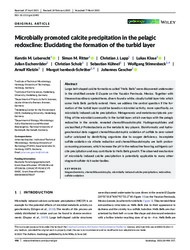Microbially promoted calcite precipitation in the pelagic redoxcline: Elucidating the formation of the turbid layer
Lapp, Christian J.
Eschenröder, Julian
Scholz, Christian
Kühnel, Sebastian
Stinnesbeck, Wolfgang
Kletzin, Arnulf
Isenbeck‐Schröter, Margot
DOI: https://doi.org/10.1111/gbi.12492
Persistent URL: http://resolver.sub.uni-goettingen.de/purl?gldocs-11858/10265
Persistent URL: http://resolver.sub.uni-goettingen.de/purl?gldocs-11858/10265
Leberecht, Kerstin M.; Ritter, Simon M.; Lapp, Christian J.; Klose, Lukas; Eschenröder, Julian; Scholz, Christian; Kühnel, Sebastian; Stinnesbeck, Wolfgang; Kletzin, Arnulf; Isenbeck‐Schröter, Margot; Gescher, Johannes, 2022: Microbially promoted calcite precipitation in the pelagic redoxcline: Elucidating the formation of the turbid layer. In: Geobiology, Band 20, 4: 498 - 517, DOI: 10.1111/gbi.12492.
 |
Dokument öffnen: |
Large bell‐shaped calcite formations called “Hells Bells” were discovered underwater in the stratified cenote El Zapote on the Yucatán Peninsula, Mexico. Together with these extraordinary speleothems, divers found a white, cloudy turbid layer into which some Hells Bells partially extend. Here, we address the central question if the formation of the turbid layer could be based on microbial activity, more specifically, on microbially induced calcite precipitation. Metagenomic and metatranscriptomic profiling of the microbial community in the turbid layer, which overlaps with the pelagic redoxcline in the cenote, revealed chemolithoautotrophic Hydrogenophilales and unclassified β‐Proteobacteria as the metabolic key players. Bioinformatic and hydrogeochemical data suggest chemolithoautotrophic oxidation of sulfide to zero‐valent sulfur catalyzed by denitrifying organisms due to oxygen deficiency. Incomplete sulfide oxidation via nitrate reduction and chemolithoautotrophy are both proton‐consuming processes, which increase the pH in the redoxcline favoring authigenic calcite precipitation and may contribute to Hells Bells growth. The observed mechanism of microbially induced calcite precipitation is potentially applicable to many other stagnant sulfate‐rich water bodies.
Statistik:
ZugriffsstatistikSammlung:
Schlagworte:
biogeochemistrychemolithoautotrophy
microbially induced calcite precipitation
redoxcline
sulfide oxidation
This is an open access article under the terms of the Creative Commons Attribution‐NonCommercial‐NoDerivs License, which permits use and distribution in any medium, provided the original work is properly cited, the use is non‐commercial and no modifications or adaptations are made.

